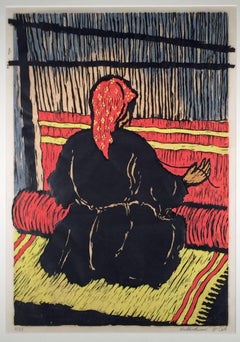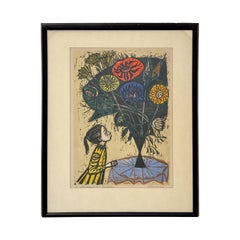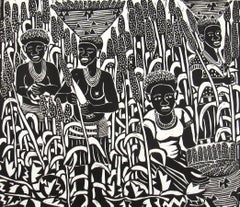Jehuda Wallersteiner Prints and Multiples
to
1
1
1
Overall Height
to
Overall Width
to
1
1
1
1
981
699
658
625
1
Artist: Jehuda Wallersteiner
UNTITLED (WOMAN WEAVING)
By Jehuda Wallersteiner
Located in Portland, ME
Wallersteiner, Jehuda Isaraeli 1915-2004). UNTITLED (WOMAN WEAVING). Woodcut in colors, not dated. Edition of 85. 38 x 26 inches.Signed in pencil and numbered. Framed,
.
Category
Jehuda Wallersteiner Prints and Multiples
Materials
Color, Woodcut
Related Items
Irving Amen, The Heart is a Garden, Signed A/P & Framed Woodblock Print
By Irving Amen
Located in Plainview, NY
A woodblock print in color, of a girl looking up at a giant flower bouquet by Irving Amen ( American, 1918-2011) . The lithograph entitled "The Heart is a Garden " is signed Amen and...
Category
20th Century Modern Jehuda Wallersteiner Prints and Multiples
Materials
Woodcut
H 34 in W 25 in D 1.5 in
Elia Shiwoohamba ( Namibia, 1981 ) Harvesting Time Lino Cut African School 2006
By Elia Shiwoohama
Located in Meinisberg, CH
Elia Shiwoohamba
(* 1981 , Windhoek, Namibia )
Harvesting Time
• African School
• Linoleum cut
• Sheet ca. 34.5 x 43 cm (Image is smaller)
• Bottom left numbered 8/50 and titled
• ...
Category
Early 2000s Expressionist Jehuda Wallersteiner Prints and Multiples
Materials
Paper, Linocut, Woodcut
Elia ShiwoohamaElia Shiwoohamba ( Namibia, 1981 ) Harvesting Time Lino Cut African School 2006, 2006
Free Shipping
H 13.59 in W 16.93 in
The kiss
Located in Ljubljana, SI
Original color woodcut, 1994. Edition of 15 signed and numbered impressions on Arches paper.
Živko Marušić is a Slovenian artist, born in Italy. He is best-known for his figurative p...
Category
1990s Post-Modern Jehuda Wallersteiner Prints and Multiples
Materials
Color, Woodcut
Hopi by Lon Megargee, Original Signed Block Print ca. 1920s
Located in Phoenix, AZ
Title: Hopi ca. 1920s
Artist: Lon Megargee
Medium: Block Print
Size: 11 x 11 inches (Sight Measurement)
Creator of Stetson's hat logo "Last Drop from his Hat"
Image of Lon Megargee not included in purchase.
Lon Megargee
1883 - 1960
At age 13, Lon Megargee came to Phoenix in 1896 following the death of his father in Philadelphia. For several years he resided with relatives while working at an uncle’s dairy farm and at odd jobs. He returned to Philadelphia in 1898 – 1899 in order to attend drawing classes at the Pennsylvania Academy of the Fine Arts. Back in Phoenix in 1899, he decided at the age of 16 to try to make his living as a cowboy.
Lon moved to the cow country of Wickenburg, Arizona where he was hired by Tex Singleton’s Bull Ranch. He later joined the Three Bar R. . . and after a few years, was offered a job by Billy Cook of the T.T. Ranch near New River. By 1906, Megargee had learned his trade well enough to be made foreman of Cook’s outfit.
Never shy about taking risks, Lon soon left Cook to try his own hand at ranching. He partnered with a cowpuncher buddy, Tom Cavness, to start the El Rancho Cinco Uno at New River. Unfortunately, the young partners could not foresee a three-year drought that would parch Arizona, costing them their stock and then their hard-earned ranch.
Breaking with his romantic vision of cowboy life, Megargee finally turned to art full time. He again enrolled at the Pennsylvania Academy of Art and then the Los Angeles School of Art and Design during 1909 – 1910. The now well-trained student took his first trip to paint “en plein air” (outdoors) to the land of Hopi and Navajo peoples in northern Arizona. After entering paintings from this trip in the annual Territorial Fair at Phoenix, in 1911, he surprisingly sold his first oil painting to a major enterprise – the Santa Fe Railroad . . . Lon received $50 for “Navajos Watching the Santa Fe Train.” He soon sold the SFRR ten paintings over the next two years. For forty years the railroad was his most important client, purchasing its last painting from him in 1953.
In a major stroke of good fortune during his early plein-air period, Megargee had the opportunity to paint with premier artist, William R. Leigh (1866 – 1955). Leigh furnished needed tutoring and counseling, and his bright, impressionistic palette served to enhance the junior artist’s sense of color and paint application. In a remarkable display of unabashed confidence and personable salesmanship, Lon Megargee, at age 30, forever linked his name with Arizona art history. Despite the possibility of competition from better known and more senior artists, he persuaded Governor George Hunt and the Legislature in 1913 to approve 15 large, historic and iconic murals for the State Capitol Building in Phoenix. After completing the murals in 1914, he was paid the then princely sum of roughly $4000. His Arizona statehood commission would launch Lon to considerable prominence at a very early point in his art career.
Following a few years of art schooling in Los Angeles, and several stints as an art director with movie studios, including Paramount, Megargee turned in part to cover illustrations for popular Western story magazines in the 1920s.
In the 1920s, as well, Lon began making black and white prints of Western types and of genre scenes from woodblocks. These prints he generally signed and sold singly. In 1933, he published a limited edition, signed and hard-cover book (about 250 copies and today rare)containing a group of 28 woodblock images. Titled “The Cowboy Builds a Loop,” the prints are noteworthy for strong design, excellent draftsmanship, humanistic and narrative content, and quality. Subjects include Southwest Indians and cowboys, Hispanic men and women, cattle, horses, burros, pioneers, trappers, sheepherders, horse traders, squaw men and ranch polo players. Megargee had a very advanced design sense for simplicity and boldness which he demonstrated in how he used line and form. His strengths included outstanding gestural (action) art and strong figurative work. He was superb in design, originality and drawing, as a study of his prints in the Hays collection reveals.
In 1944, he published a second group of Western prints under the same title as the first. Reduced to 16 images from the original 28 subjects, and slightly smaller, Lon produced these prints in brown ink on a heavy, cream-colored stock. He designed a sturdy cardboard folio to hold each set. For the remainder of his life, Lon had success selling these portfolios to museum stores, art fairs and shows, and to the few galleries then selling Western art.
Drawing on real working and life experiences, Lon Megargee had a comprehensive knowledge, understanding and sensitivity for Southwestern subject matter. Noted American modernist, Lew Davis...
Category
1920s American Impressionist Jehuda Wallersteiner Prints and Multiples
Materials
Woodcut
Félix Vallotton ( Swiss 1865 - 1925) L’Exécution Woodcut 18/25 , Switzerland
By Félix Vallotton
Located in Meinisberg, CH
Félix Vallotton
(Swiss, 1865 - 1925)
L’Exécution
• Wood cut print
• Loose Japan paper sheet, 25 x 37 cm
• Block, ca. 15 x 25 cm
• Monogrammed in the ...
Category
1890s Expressionist Jehuda Wallersteiner Prints and Multiples
Materials
Paper, Ink, Woodcut
Free Shipping
H 9.85 in W 14.57 in
Coal Miners - INDUSTRIAL ART - Pre War German School - Large signed Woodcut
Located in Meinisberg, CH
Hermann Kätelhön
(German, * 22. September 1884, Hofgeismar; † 24. November 1940, München)
Coal Miners
• Woodcut, sheet measures ca. 55 x 40 cm
• The sheet is mounted (fixed at the...
Category
1920s Naturalistic Jehuda Wallersteiner Prints and Multiples
Materials
Paper, Ink, Woodcut
Free Shipping
H 21.66 in W 15.75 in D 0.4 in
Violinist
Located in Berlin, MD
Engelina (Engelien) Reitsma-Valença (3 May 1889 - 11 July 1981) Amsterdam, Netherland. The portrait is of a violinist playing what appears to be an enervating piece. An engraver, st...
Category
Early 20th Century Art Deco Jehuda Wallersteiner Prints and Multiples
Materials
Woodcut
Le Vieux Manuscrits, Coree-Seoul
By Paul Jacoulet
Located in Rio Vista, CA
Fascinating artwork titled Le Vieux manusrits (old writings Seoul Korea) by Paul Jacoulet. (French-Japanese 1896-1960) finely crafted with lovely graduating background color blue to light green. Depicts a figure seated on a pink pillow wearing a Korean hat...
Category
20th Century Realist Jehuda Wallersteiner Prints and Multiples
Materials
Woodcut
"Fieldwork" Large 5+-Foot Original Woodcut on Paper by Roger Herman, Framed
By Roger Herman
Located in Encino, CA
"Fieldwork," an original woodcut on paper by Roger Herman, is a piece for the true collector. This spectacular woodcut cannot be properly communicated digitally – it is a far more impactful and meaningful experience in person. This work of art would definitely enhance most homes or professional settings, perfect for those who have an affinity for abstracts, Neo-Expressionism, modernist paintings, or postmodern art. This woodcut was printed by Hans-Fuss and published by the Graphic Arts Council at LACMA. Work is outfitted with custom, conservation frame.
Art historian Howard Singerman's words from the December 1982 ArtForum Magazine:
"...Herman's expressionistic style... with its roots in German Expressionism and the New York School, is previously painted. His mean colors, thick pigment, and quick strokes are not a direct record of emotion and activity, they are not painting outside language, but signs for that painting, for an emotion and an activity that are no longer available. The expressionist act is recast as romantic aspiration; in his inscription, Herman evokes painting's past and admits his need for its aura...
...Herman's distance even undermines the emblematic immediacy of his expressionism, which he uses to attain more distance still. Unlike the flattened, aggressive figures that push to, and threaten to push through, the surfaces of most new painting, Herman's figures are situated in middle ground and buried beneath the paint..."
Artist: ROGER HERMAN (1947-)
Title: FIELDWORK
Medium & Surface: ORIGINAL WOODCUT ON PAPER (framed)
Signed/Numbered: HAND-SIGNED, NUMBERED, AND TITLED BY ARTIST
Number: 36 of 75
Year Created: 1984
Country of Creation: UNITED STATES
Image Area Dimensions: 24 x 48 INCHES
Paper Dimensions: 38 x 62 INCHES
Frame Dimensions:* 41.25 x 65.25 x 1 INCHES
*This work of art is being sold framed. If you would like to change the frame to better match your style or environment, please contact us for Custom Archival Framing options.
Additional Info: HIGHLY COLLECTIBLE WORK BY ROGER HERMAN – PRINTED BY HANS-FUSS WITH BLIND STAMP LOWER RIGHT. PUBLISHED BY THE GRAPHIC ARTS COUNCIL AT LACMA. FEATURES CUSTOM CONSERVATION FRAME.
Artist Info/Bio: ARTIST BIOGRAPHY DOCUMENT IS INCLUDED
Documentation: CERTIFICATE OF AUTHENTICITY IS INCLUDED
About the Artist: Roger Herman, a German painter and ceramic artist, has become well known for the broad range of styles encompassed within his work across multiple mediums.
Roger Herman was born in Germany in 1947, where he began his studies at the Kunstakademie in Karlsruhe. In 1976, he was offered a fellowship from the German Academic Exchange Service (DAAD), which took him across the world to San Francisco. It was here, in California, that his career began to flourish.
He started by creating paintings of phenomenal proportion, soon christened as the West Coast parallel of the 80s Neo-expressionist movement. It was highly referential work, drawing on his knowledge of art history, as well as his famed sense of humor. With loose, facile brushwork, his art is reminiscent of the figurative German painters who emerged in the 1970s—like Markus Lüpertz (who taught at the Kunstakademie), Rainer Fetting...
Category
1980s Neo-Expressionist Jehuda Wallersteiner Prints and Multiples
Materials
Woodcut
No Reserve
H 41.25 in W 65.25 in D 1 in
The War Bonnet by Lon Megargee
Located in Phoenix, AZ
Lon Megargee 1883-1960
"The War Bonnet"
Wood block print
Signed: original pencil signature, lower right
Image size: 11 x 11 inches
Frame size 22 x 22 inches
Creator of Stetson's hat logo "Last Drop from his Hat"
Lon Megargee
1883 - 1960
At age 13, Lon Megargee came to Phoenix in 1896 following the death of his father in Philadelphia. For several years he resided with relatives while working at an uncle’s dairy farm and at odd jobs. He returned to Philadelphia in 1898 – 1899 in order to attend drawing classes at the Pennsylvania Academy of the Fine Arts. Back in Phoenix in 1899, he decided at the age of 16 to try to make his living as a cowboy.
Lon moved to the cow country of Wickenburg, Arizona where he was hired by Tex Singleton’s Bull Ranch. He later joined the Three Bar R. . . and after a few years, was offered a job by Billy Cook of the T.T. Ranch near New River. By 1906, Megargee had learned his trade well enough to be made foreman of Cook’s outfit.
Never shy about taking risks, Lon soon left Cook to try his own hand at ranching. He partnered with a cowpuncher buddy, Tom Cavness, to start the El Rancho Cinco Uno at New River. Unfortunately, the young partners could not foresee a three-year drought that would parch Arizona, costing them their stock and then their hard-earned ranch.
Breaking with his romantic vision of cowboy life, Megargee finally turned to art full time. He again enrolled at the Pennsylvania Academy of Art and then the Los Angeles School of Art and Design during 1909 – 1910. The now well-trained student took his first trip to paint “en plein air” (outdoors) to the land of Hopi and Navajo peoples in northern Arizona. After entering paintings from this trip in the annual Territorial Fair at Phoenix, in 1911, he surprisingly sold his first oil painting to a major enterprise – the Santa Fe Railroad . . . Lon received $50 for “Navajos Watching the Santa Fe Train.” He soon sold the SFRR ten paintings over the next two years. For forty years the railroad was his most important client, purchasing its last painting from him in 1953.
In a major stroke of good fortune during his early plein-air period, Megargee had the opportunity to paint with premier artist, William R. Leigh (1866 – 1955). Leigh furnished needed tutoring and counseling, and his bright, impressionistic palette served to enhance the junior artist’s sense of color and paint application. In a remarkable display of unabashed confidence and personable salesmanship, Lon Megargee, at age 30, forever linked his name with Arizona art history. Despite the possibility of competition from better known and more senior artists, he persuaded Governor George Hunt and the Legislature in 1913 to approve 15 large, historic and iconic murals for the State Capitol Building in Phoenix. After completing the murals in 1914, he was paid the then princely sum of roughly $4000. His Arizona statehood commission would launch Lon to considerable prominence at a very early point in his art career.
Following a few years of art schooling in Los Angeles, and several stints as an art director with movie studios, including Paramount, Megargee turned in part to cover illustrations for popular Western story magazines in the 1920s.
In the 1920s, as well, Lon began making black and white prints of Western types and of genre scenes from woodblocks. These prints he generally signed and sold singly. In 1933, he published a limited edition, signed and hard-cover book (about 250 copies and today rare)containing a group of 28 woodblock images. Titled “The Cowboy Builds a Loop,” the prints are noteworthy for strong design, excellent draftsmanship, humanistic and narrative content, and quality. Subjects include Southwest Indians and cowboys, Hispanic men and women, cattle, horses, burros, pioneers, trappers, sheepherders, horse traders, squaw men and ranch polo players. Megargee had a very advanced design sense for simplicity and boldness which he demonstrated in how he used line and form. His strengths included outstanding gestural (action) art and strong figurative work. He was superb in design, originality and drawing, as a study of his prints in the Hays collection reveals.
In 1944, he published a second group of Western prints under the same title as the first. Reduced to 16 images from the original 28 subjects, and slightly smaller, Lon produced these prints in brown ink on a heavy, cream-colored stock. He designed a sturdy cardboard folio to hold each set. For the remainder of his life, Lon had success selling these portfolios to museum stores, art fairs and shows, and to the few galleries then selling Western art.
Drawing on real working and life experiences, Lon Megargee had a comprehensive knowledge, understanding and sensitivity for Southwestern subject matter. Noted American modernist, Lew...
Category
Early 20th Century American Impressionist Jehuda Wallersteiner Prints and Multiples
Materials
Woodcut
Women in a Garden
By Toyohara Chikanobu
Located in Austin, TX
Tohoyara Chikanobu
"Women in a Garden"
Woodcut print on Paper
Tryptich totalling 13 x 29"
Framed size 20 x 35"
The triptych of woodcut prints features a classic scene of a garden in...
Category
Late 19th Century Jehuda Wallersteiner Prints and Multiples
Materials
Rice Paper, Woodcut
Dogs 2 - Contemporary Woodcut Print, Figurative, Black & white, Polish artist
By Zdzislaw Wiatr
Located in Warsaw, PL
ZDZISŁAW WIATR (born 1960)
He graduated from the Academy of Fine Arts in Cracow, at the Faculty of Graphic Arts in Katowice, where in 1986 he received a diploma with the honourable m...
Category
21st Century and Contemporary Contemporary Jehuda Wallersteiner Prints and Multiples
Materials
Paper, Woodcut
Jehuda Wallersteiner prints and multiples for sale on 1stDibs.
Find a wide variety of authentic Jehuda Wallersteiner prints and multiples available for sale on 1stDibs. You can also browse by medium to find art by Jehuda Wallersteiner in woodcut print and more. Not every interior allows for large Jehuda Wallersteiner prints and multiples, so small editions measuring 36 inches across are available. Customers who are interested in this artist might also find the work of Toyohara Kunichika, Jean Louis Forain, and Robert Kasimir. Jehuda Wallersteiner prints and multiples prices can differ depending upon medium, time period and other attributes. On 1stDibs, the price for these items starts at $750 and tops out at $750, while the average work can sell for $750.


